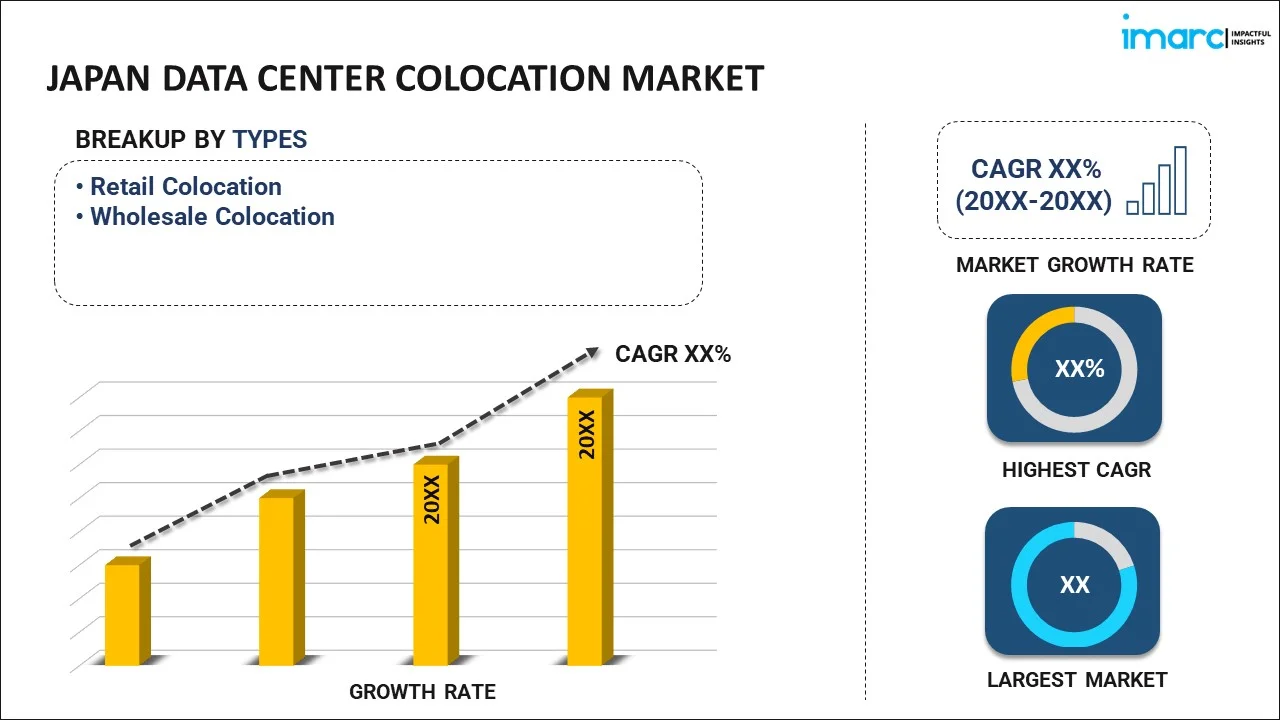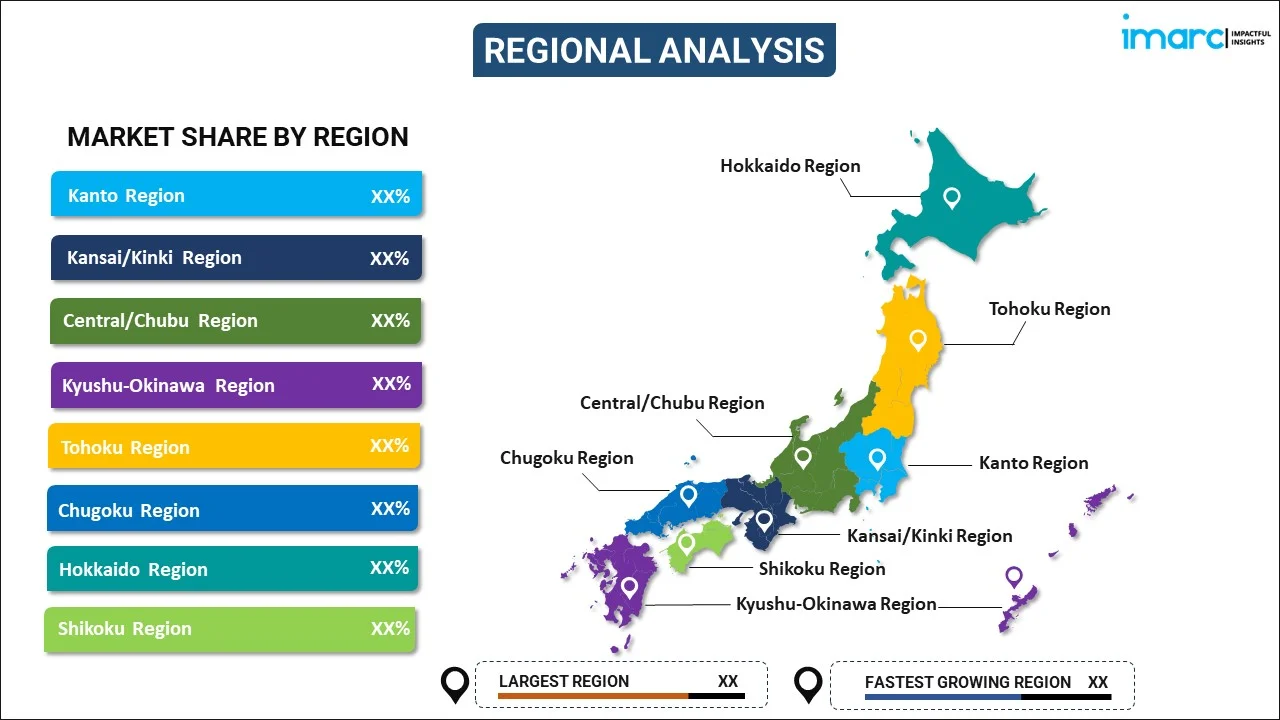
Japan Data Center Colocation Market Report by Type (Retail Colocation, Wholesale Colocation), Organization Size (Small and Medium Enterprises, Large Enterprises), End Use Industry (BFSI, Manufacturing, IT and Telecom, Energy, Healthcare, Government, Retail, Education, Entertainment and Media, and Others), and Region 2025-2033
Market Overview:
Japan data center colocation market size reached USD 4.4 Billion in 2024. Looking forward, IMARC Group expects the market to reach USD 14.4 Billion by 2033, exhibiting a growth rate (CAGR) of 14.2% during 2025-2033. The elevating utilization of reliable, scalable and secure infrastructures for efficient data recovery is primarily driving the market growth.
|
Report Attribute
|
Key Statistics
|
|---|---|
|
Base Year
|
2024 |
|
Forecast Years
|
2025-2033 |
|
Historical Years
|
2019-2024
|
| Market Size in 2024 | USD 4.4 Billion |
| Market Forecast in 2033 | USD 14.4 Billion |
| Market Growth Rate (2025-2033) | 14.2% |
Data center colocation is a service that allows businesses to lease physical space, network bandwidth, and other computing resources within an established data center infrastructure. These data centers come equipped with built-in networking components, backup power systems, information protocols (IP), and cooling mechanisms, and they are typically available in both retail and wholesale configurations. Compared to conventional data centers, colocation data centers offer cost-efficiency, heightened reliability, scalability, proximity to end-users, and reduced technical personnel requirements. As a result, they have diverse applications across various industries, including banking, financial services, insurance (BFSI), healthcare, information technology (IT), manufacturing, energy, government, and retail sectors.
Japan Data Center Colocation Market Trends:
The Japan market is significantly influenced by the widespread adoption of digitalization across various industries. This surge in digitalization has created a growing need for hybrid cloud computing and virtualization systems, thereby fueling the demand for data center colocation services in the country. Additionally, there is an increasing requirement for secure and scalable infrastructure to support efficient data recovery and business continuity, serving as another significant driver for market growth. Furthermore, the substantial increase in data volumes stemming from social media platforms and over-the-top (OTT) media services has generated a heightened demand for reliable data centers, which is positively influencing the regional market. The adoption of Internet-of-Things (IoT) technology in various organizations has also driven the need for higher network bandwidth, faster data processing with reduced latency, and enhanced connectivity. In this context, colocation data centers have become a preferred choice for end-users seeking efficient solutions. Other factors contributing to market growth include the emergence of 5G technology, extensive demand for data storage facilities in the e-commerce sector, and ongoing enhancements in IT infrastructure. These factors are collectively expected to propel the expansion of the colocation data center market in Japan over the forecasted period.
Japan Data Center Colocation Market Segmentation:
IMARC Group provides an analysis of the key trends in each segment of the market, along with forecasts at the country level for 2025-2033. Our report has categorized the market based on type, organization size, and end use industry.
Type Insights:

- Retail Colocation
- Wholesale Colocation
The report has provided a detailed breakup and analysis of the market based on the type. This includes retail colocation and wholesale colocation.
Organization Size Insights:
- Small and Medium Enterprises
- Large Enterprises
A detailed breakup and analysis of the market based on the organization size have also been provided in the report. This includes small and medium enterprises and large enterprises.
End Use Industry Insights:
- BFSI
- Manufacturing
- IT and Telecom
- Energy
- Healthcare
- Government
- Retail
- Education
- Entertainment and Media
- Others
The report has provided a detailed breakup and analysis of the market based on the end use industry. This includes BFSI, manufacturing, IT and telecom, energy, healthcare, government, retail, education, entertainment and media, and others.
Regional Insights:

- Kanto Region
- Kansai/Kinki Region
- Central/ Chubu Region
- Kyushu-Okinawa Region
- Tohoku Region
- Chugoku Region
- Hokkaido Region
- Shikoku Region
The report has also provided a comprehensive analysis of all the major regional markets, which include Kanto Region, Kansai/Kinki Region, Central/ Chubu Region, Kyushu-Okinawa Region, Tohoku Region, Chugoku Region, Hokkaido Region, and Shikoku Region.
Competitive Landscape:
The market research report has also provided a comprehensive analysis of the competitive landscape. Competitive analysis such as market structure, key player positioning, top winning strategies, competitive dashboard, and company evaluation quadrant has been covered in the report. Also, detailed profiles of all major companies have been provided.
Japan Data Center Colocation Market Report Coverage:
| Report Features | Details |
|---|---|
| Base Year of the Analysis | 2024 |
| Historical Period | 2019-2024 |
| Forecast Period | 2025-2033 |
| Units | Billion USD |
| Scope of the Report | Exploration of Historical and Forecast Trends, Industry Catalysts and Challenges, Segment-Wise Historical and Predictive Market Assessment:
|
| Types Covered | Retail Colocation, Wholesale Colocation |
| Organization Sizes Covered | Small and Medium Enterprises, Large Enterprises |
| End Use Industries Covered | BFSI, Manufacturing, IT and Telecom, Energy, Healthcare, Government, Retail, Education, Entertainment and Media, Others |
| Regions Covered | Kanto Region, Kansai/Kinki Region, Central/ Chubu Region, Kyushu-Okinawa Region, Tohoku Region, Chugoku Region, Hokkaido Region, Shikoku Region |
| Customization Scope | 10% Free Customization |
| Post-Sale Analyst Support | 10-12 Weeks |
| Delivery Format | PDF and Excel through Email (We can also provide the editable version of the report in PPT/Word format on special request) |
Key Questions Answered in This Report:
- How has the Japan data center colocation market performed so far and how will it perform in the coming years?
- What has been the impact of COVID-19 on the Japan data center colocation market?
- What is the breakup of the Japan data center colocation market on the basis of type?
- What is the breakup of the Japan data center colocation market on the basis of organization size?
- What is the breakup of the Japan data center colocation market on the basis of end use industry?
- What are the various stages in the value chain of the Japan data center colocation market?
- What are the key driving factors and challenges in the Japan data center colocation?
- What is the structure of the Japan data center colocation market and who are the key players?
- What is the degree of competition in the Japan data center colocation market?
Key Benefits for Stakeholders:
- IMARC’s industry report offers a comprehensive quantitative analysis of various market segments, historical and current market trends, market forecasts, and dynamics of the Japan data center colocation market from 2019-2033.
- The research report provides the latest information on the market drivers, challenges, and opportunities in the Japan data center colocation market.
- Porter's five forces analysis assist stakeholders in assessing the impact of new entrants, competitive rivalry, supplier power, buyer power, and the threat of substitution. It helps stakeholders to analyze the level of competition within the Japan data center colocation industry and its attractiveness.
- Competitive landscape allows stakeholders to understand their competitive environment and provides an insight into the current positions of key players in the market.
Need more help?
- Speak to our experienced analysts for insights on the current market scenarios.
- Include additional segments and countries to customize the report as per your requirement.
- Gain an unparalleled competitive advantage in your domain by understanding how to utilize the report and positively impacting your operations and revenue.
- For further assistance, please connect with our analysts.
 Inquire Before Buying
Inquire Before Buying
 Speak to an Analyst
Speak to an Analyst
 Request Brochure
Request Brochure
 Request Customization
Request Customization




.webp)




.webp)












